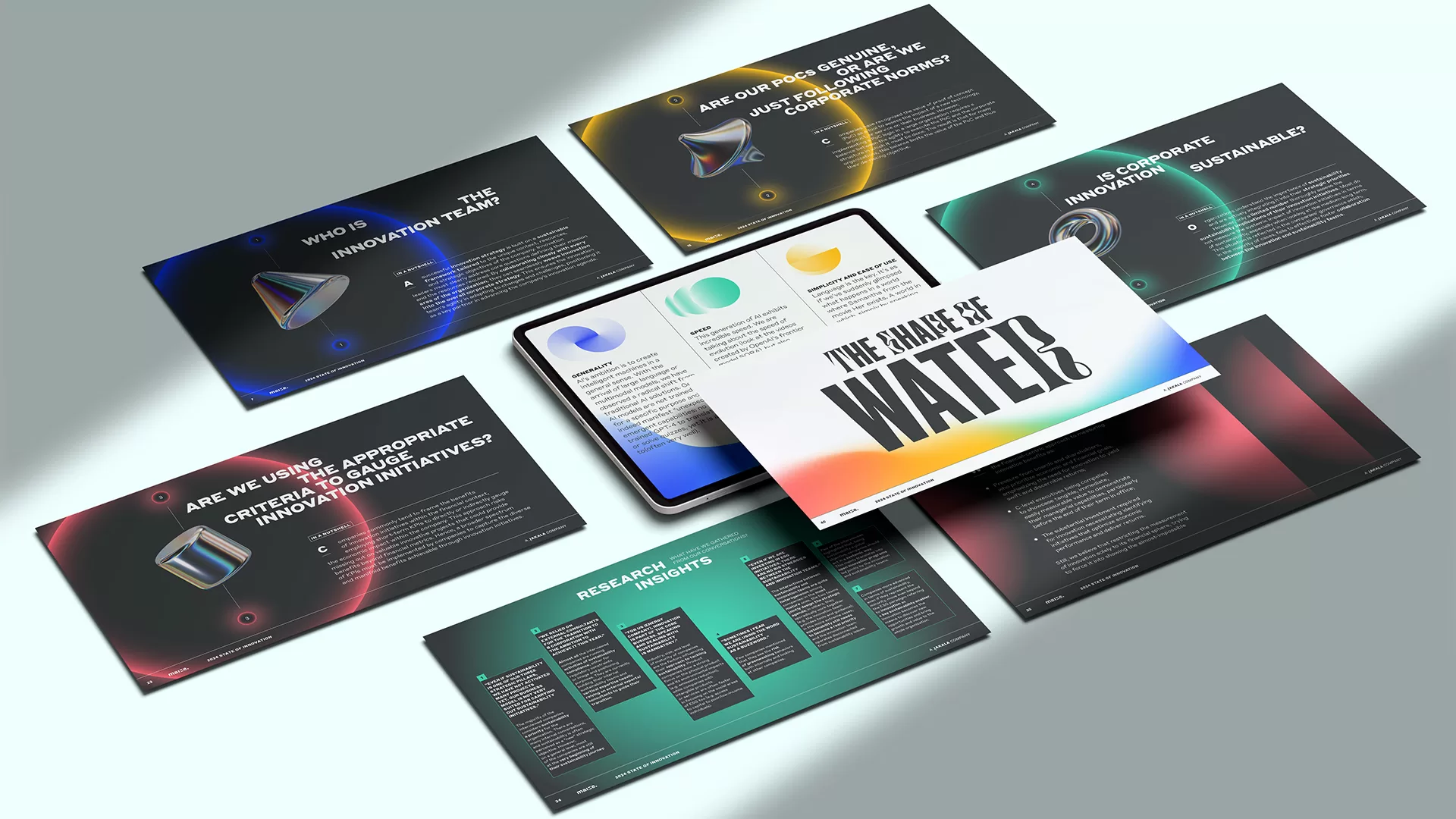The shape of water. Innovation in the era of AI

Moriella Kowalski
Partner, MAIZE

Vittorio Di Tomaso
Partner, MAIZE
Transformative innovation
2024

Innovation functions have traditionally functioned as sentinels, introducing the larger company populations to what was new. With its disruptive, breakneck pace, AI is changing that (too), prompting us to question what the future holds for them
The elephant in the room: more intelligent machines
It is impossible to discuss the state of innovation without acknowledging the elephant in the room: AI, in its current iteration, which we have come to call generative AI. The emergence of language models such as OpenAI’s GPT-4, Anthropic’s Claude, Google’s Gemini, and others has suddenly revolutionized a field that seemed to be progressing more slowly than its ambitions for the past 70 years. Large language models (LLMs) have abruptly shown us the potential of reasoning machines, something we had never seen before. Without falling into excessive techno-optimism, we must acknowledge a genuine turning point in the discipline, characterized precisely by language and reasoning. Multimodal models, like GPT-4 and Gemini, are no longer limited to recognizing patterns and regularities in data, they have now become capable of supporting humans in exploration, analysis, and meaning extraction from conversations, exhibiting a surprising understanding of the data they are exposed to, although sometimes still unexpectedly superficial and fragile.
A new hypothesis for corporate innovation
As strategic design companies operating in the innovation arena, we have been guiding organizations of various sizes and industries for over 15 years to establish, enhance, and implement their innovation strategies. The AI tsunami we are witnessing is overturning established corporate beliefs, roadmaps, priorities, and industrial plans, pushing organizations to rethink their role and the potential of innovation.
If we explore the types of conversations we’ve had with our clients over the last year, most of them haven’t even been with the innovation functions. Most conversations happened directly with business functions and if not them directly, then, with CTOs or CIOs. Most AI projects sold last year were sought after and bought directly by business (in collaboration with IT), and that puts us in front of an interesting hypothesis: “Has GenAI and its potential managed to overtake and leave the innovation functions behind?”
In other words, it seems that in the face of such radically disruptive technology, in many cases, innovation functions embedded as organizational units are “struggling” to respond with speed and a clear and strategic roadmap to this change. Faced with this struggle, organizations — particularly business and technology functions that have people and substantial budgets — have simply “done it themselves.”
MAIZE adaptation from EY article “How Gen AI governance framework can help build trust in tomorrow’s tech”.
A new hypothesis for corporate innovation
This hypothesis might seem bold, but let’s explore it further. If we look at the two extreme macro-archetypes of innovation models and structures within organizations, we can observe that:
- The first archetype is the one that managed over the years to seed innovation ambassadors with an inventive mindset throughout the organization for them to directly identify potential, explore, pioneer, and experiment within their own vertical domain.
- The second archetype followed a more centralized experimental path looking to educate and generate transformative opportunities on a smaller scale and with very specific applications.
From our experience, companies that adopted the first archetype years back are more ready to embrace and scale emerging opportunities (such as gen AI), identifying not only the business value but also having the levers (people, budget, and use cases) for potential industrialization. The arrival of AI and its direct escalation of radical change in the innovation cycle obviously requires a different approach because AI is not “just a technology.” We have to take into account some specific characteristics of AI such as:
![]()
GENERALITY
AI’s ambition is to create intelligent machines in a general sense. With the arrival of large language or multimodal models, we have observed a radical shift from traditional AI solutions. Gen AI models are not trained for a specific purpose and indeed manifest “unexpected,” emergent capabilities: no one trained GPT-4 to translate or solve quizzes, yet it is able to (often very well).
![]()
SPEED
This generation of AI exhibits incredible speed. We are talking about the speed of evolution (look at the videos created by OpenAI’s frontier model SORA), but also adoption speed: ChatGPT took just a few days to reach 1M users, and Microsoft made copilots accessible to all Office365 users within a few months: that’s about 345 million paying users, meaning half of all personal productivity software users. This speed is impressive, especially when combined with the trajectory toward generality mentioned above.
![]()
SIMPLICITY AND EASE OF USE
Language is the key. It’s as if we’ve suddenly glimpsed what happens in a world where Samantha from the movie Her exists. A world in which, simply by speaking, we can interact with the entire digital (and perhaps even physical) universe. We can ask for anything, satisfy any informational need, and create any text, image, or sound: we just need to know how to ask. A genie lamp for everyone: no technology has ever been so easy to use.
![]()
INTELLIGENCE
This is the big thing, and the usual qualifications about what intelligence is, how complex and articulated it is, apply: these machines are not intelligent like humans (or cats or bees), but we must observe that these architectures are likely expressive enough for sophisticated internal structure to emerge with scale and diverse training data. These machines speak, reason, and create coherent images and videos: we might not call it intelligence, but we cannot ignore these phenomena. And remain surprised almost every time.
The dilemma of traditional innovation
Historically, the innovation function has been seen as the engine of progress and competitive differentiation within companies. However, the advent and rise of AI have highlighted significant limitations in this approach. AI, with its capabilities for autonomous learning, language competence, and task automation, requires an adoption speed and adaptability that often surpass the structures and processes of the traditional innovation function.
This is why we have witnessed a transformation led primarily by business necessities and emerging technological opportunities: business units, with their proximity to the market, customers, and competition, are in a privileged position to identify AI applications that can generate the most added value. Simultaneously, IT and technological departments, with their expertise and vision of new technologies, become essential catalysts in integrating AI into business operations.
Faced with this reality, the traditional innovation function finds itself at a crossroads. On one hand, its existence as a separate entity risks becoming an anachronism, incapable of keeping pace with rapid technological evolutions and the increasingly pressing needs of the business. On the other hand, completely abandoning this function would mean losing not only the potential of rapidly incubating innovative ideas and solutions, but also that innovative “mindset” that is so distinct and characteristic of those experts who engage in it daily and are so needed for making time to market impact.
The challenge, then, is to rethink the role of the innovation function in a way that can effectively contribute to the AI-driven transformation, both directly and indirectly. This could mean a closer integration between innovation, business, and technology with the innovation function acting as a facilitator and coordinator of cross‑functional initiatives. Such a configuration would leverage the deep market knowledge and customer proximity of the business, alongside the technological competence of IT departments, enriched with the strategic vision and experimental approach typical of innovation. Only through such renewal can the innovation function overcome the challenge posed by AI and actively contribute to business transformation in the digital age. The era of “retail”, tick-the-box, small-scale innovation is over.

Looking forward
Let’s celebrate change and progress! This transformative period allows for the challenging of long-held assumptions, the leveraging of expert opinions, the development of future‑oriented scenarios with tangible metrics, the democratization and harnessing of data-driven insights, and the proposition of radical ideas that could redefine industries. Integrating these is imperative.
![]()
CHALLENGE ASSUMPTIONS
The first step in embracing this opportunity is to question the status quo. Organizations must critically assess their existing business models, processes, and strategies to identify where assumptions and drivers about market stability, customer behavior, and competitive landscapes may no longer hold true in the face of AI’s capabilities. This involves a willingness to reconsider every aspect of operations through the lens of what AI makes possible, from product development to customer service. In this case, AI can be used to generate growth assumptions, design experiments for validation, simulate user feedback, act as a governing project planner, and identify risks.
![]()
CONNECT WITH EXPERT OPINIONS
As AI continues to evolve, staying informed and connected with leading thinkers in the field becomes crucial. Organizations should seek to build relationships with AI researchers, industry analysts, and thought leaders to gain insights into emerging trends, potential applications, and ethical considerations. This network of expertise can provide valuable guidance as companies navigate the complexities of integrating AI into their strategic planning.
![]()
DEVELOP SCENARIOS AND METRICS
Understanding the potential impact of AI requires a structured approach to scenario planning. Organizations should develop a range of possible futures, from the incremental to the transformative, that AI could bring about in their industry. For each scenario, defining specific, measurable metrics will enable the tracking of progress and the assessment of impact. This forward-looking approach helps organizations prepare for multiple outcomes, making them more resilient and adaptable.
![]()
DATA-DRIVEN INSIGHTS
The power of AI to process and analyze vast and varied amounts of data at unprecedented speeds offers organizations new ways to uncover insights and make informed decisions. Combining data from various sources and domain experts (quantitative and qualitative). By leveraging AI for data analytics, companies can identify patterns, trends, and opportunities and immediately generate new validation assumptions to develop scenarios. This capability allows for more nuanced and structured decision-making.
![]()
PROPOSE RADICAL IDEAS
Finally, the arrival of intelligent machines encourages organizations to think boldly. With the constraints of traditional processes and limitations of human cognition being redefined by AI, companies have the freedom to propose and pursue radical ideas that could lead to disruptive innovations. Whether it’s developing new business models, creating novel products and services, or reimagining customer experiences, the goal is to leverage AI not just for incremental improvements but for groundbreaking change.
The arrival of AI challenges companies to not only reimagine their strategies but to fundamentally alter their operational DNA. This is not the time for half measures or the faint‑hearted. In this context, the role of the innovation function within organizations is more critical than ever. Innovation today has the opportunity to turn into a collaborative dynamic force that drives strategic transformation. It becomes a complimentary partner for business‑driven initiatives that must be led with speed, autonomy, and understanding of technology. As we navigate this uncharted territory, one thing is certain: the businesses that will emerge as leaders in the intelligent machine age are those that view this technological tsunami not as a threat but as the ultimate catalyst for change and know how to leverage internal talent to scale. In the end, the measure of success in this new era will not be how well businesses adapted to AI, but how they harnessed it to transform themselves — and, by extension, the world around them.
The big picture
AI will unquestionably have an impact on the way we work, and likely much further beyond. In a way, as we have shown, it already is. However, its nature is one of a wildly unpredictable phenomenon, which might either supercharge the innovation insights we have gathered or somehow flip the table on its head and make everything obsolete. It’s something companies need to be on top of; a wave to learn how to ride and not be drowned from. Still, this uncertainty can’t be a reason to give up and preemptively reshape everything else. Indeed, it’s worth going back to the four foundational questions that emerged during our research.
Read more about our insights on AI and innovation by downloading our full “2024 State of Innovation” report.










